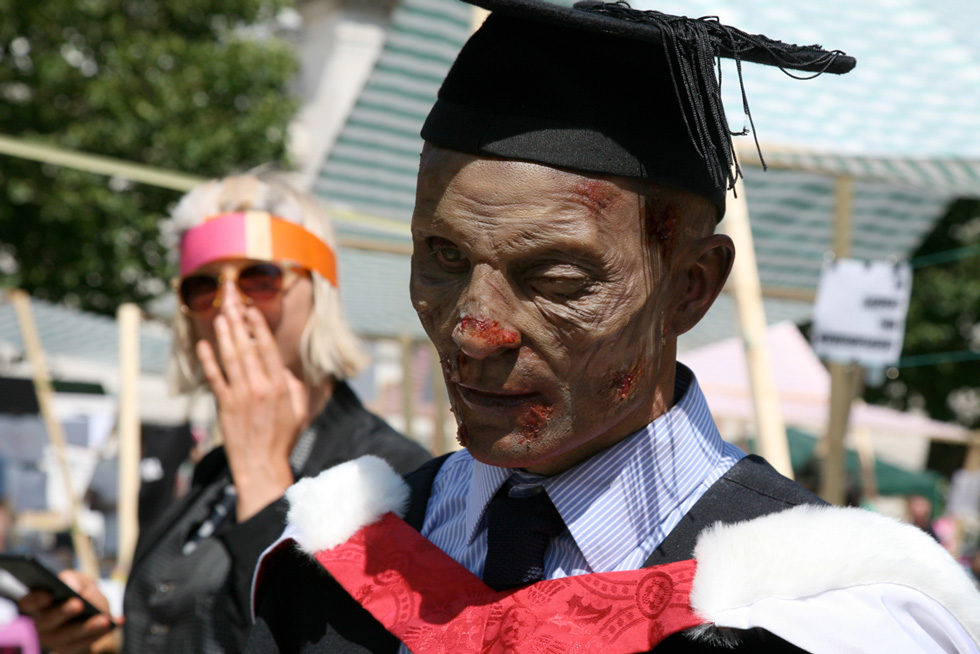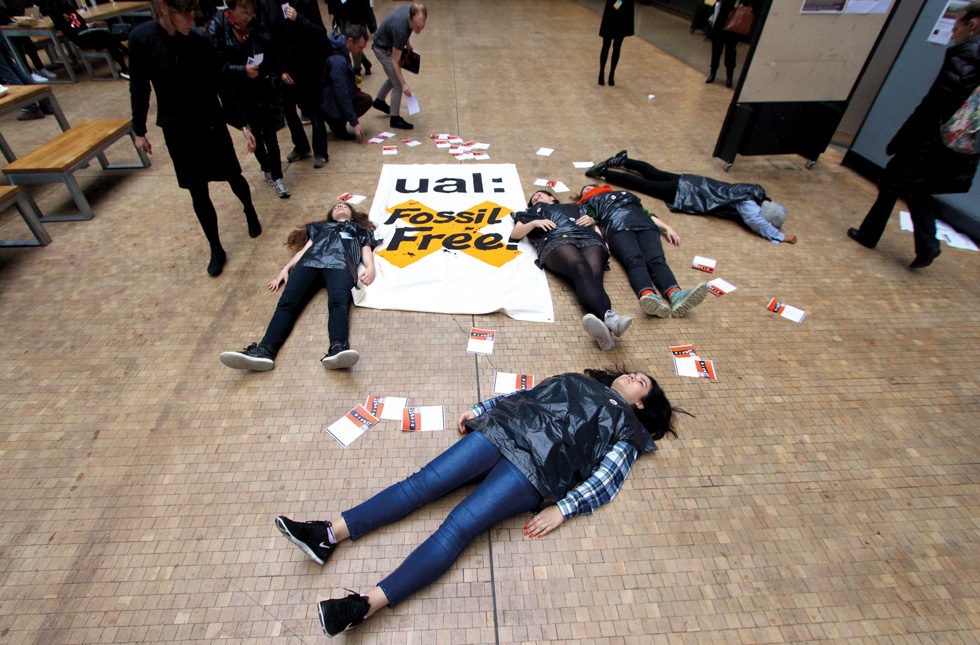A GLIMPSE OF HOW WE MIGHT BECOME AGENTS OF CHANGE
DAVID CROSS
In March 2013, UAL Vice Chancellor Nigel Carrington publicly committed UAL to tackling climate change and helping the transition to a post carbon society.1The People & Planet Green Education Declaration See peopleandplanet.org/green-education-declaration/signatories (accessed 30 April 2016). Recommending rapid action to keep up with the students, I sent him and his team research briefings on climate change, financial instability and the risk of fossil fuels becoming ‘stranded assets’2For a definition and discussion of stranded assets, see for example, Atif Ansar, Ben Caldecott and James Tilbury, ‘Stranded Assets and the Fossil Fuel Divestment Campaign: what does divestment mean for the valuation of fossil fuel assets?’ Stranded Assets Programme, Smith School of Enterprise and Environment, University of Oxford, 8 October 2013.. I alerted them to the ‘reputational risks’ of banking with the Royal Bank of Scotland, and proposed that UAL could be the first UK university to divest from fossil fuels.
Inspired by Bill McKibben, 350.org., People & Planet and Platform, I gave lectures throughout 2013 and 2014,3See for example the Mapping Art Practices conference, Hoxton Town Hall, London, organised by Standpoint Gallery, 24 June 2014. http://2012.a-n.co.uk/news/single/sympoisum-set-to-map-uk-wide-art-practice/5 (accessed 30 April 2016) proposing that UAL should divest from fossil fuels, and reinvest in renewable energy that is decentralised, diversified and democratically controlled.4See www.rollingstone.com/politics/news/global-warmings-terrifying-new-math-20120719; www.350.org and www.peopleandplanet.org. (accessed 30 April 2016). Several students joined me to form the Divest UAL campaign. I provided research material; the students submitted Freedom of Information requests; I painted banners; the students started a petition and Facebook group; I raised the issue with colleagues and lobbied senior management; the students held stalls at UAL events; we all went on demonstrations for fossil fuel divestment.
TransActing – A Market of Values5See www.criticalpracticechelsea.org/wiki/index.php?title=TransActing:_A_Market_of_Values and www.criticalpracticechelsea.org/wiki/index.php?title=Market_of_Values (accessed 30 April 2016). in July 2015 was a turning point for Divest UAL, and perhaps for the relationship between my teaching, practice and research. I decided to present a rhetorical inversion of the political activism of the Divest UAL group, the sociable collectivity of Transacting and the progressive idealism of sustainability. The students agreed to hold a fossil fuel divestment stall, freeing me to try my first art performance, in which I satirically personified the conflicted idea of ‘sustainable growth’, which for an artist/academic implies sharing social skills in the service of an economic system causing ecological destruction. I hired my graduation robes for Master of Arts at the Royal College of Art, and paid a makeup artist to give my flesh the appearance of putrefaction, in homage to the Occupy movement’s use of the zombie as the figure of neoliberalism.

Amidst the warmth and conviviality, I made a revolting spectacle of myself as the living dead: a tenured academic, obsessing over the destruction of social value through the pursuit of profit, yet implicated in the commodification of my own cognitive and affective labour. I ‘acted out’ my arrested development as a lone researcher, a pathetic one-person pageant of academic heritage. I recalled the tradition of the robed mystic in the marketplace, dispensing predictions, knowledge or wisdom in return for payment. But I barely spoke, and asked for nothing. I titled the performance, ‘Master of the Universe’, in reference to the financiers cynically inflicting the global financial crisis, and to the Masters of the University, pragmatically negotiating the resulting problems.
In October 2015, the Divest UAL students staged a ‘die-in’ at Central Saint Martins. In the busy concourse of the art school, housed in a corporate building rented from private property developer Argent (whose security staff patrol the premises), the students spread out their banner, lay down and ‘died’.

Ambiguously poised between defiance and capitulation, their action complemented carefully gathered evidence and reasoned argument with an almost desperate psychological affect. I have seen public ‘die-ins’ involving many more people, but I was moved by these students’ solidarity and courage. Enacted in a place where they are well-known, their gesture as a minority was to put themselves in a position of symbolic vulnerability, highly visible on the unstable border between art and activism.
In November 2015 UAL announced that it would divest its endowments of £3.9 million from fossil fuels, and sign the United Nations Principles for Responsible Investment. But the announcement didn’t acknowledge the work of Divest UAL. So, presenting an update on sustainability to the November 2015 Professors and Readers Committee, I said that congratulations were due — to the students of Divest UAL, and to the management of UAL for responding to them. The campaign reduced our exposure to the risks of fossil fuel, and our contribution to climate change. By reaching out across divisions between the university’s curriculum, operations and governance, it also offered a glimpse of how, as a community of practice, we might become agents of change.
At the February 2016 Committee, I drew attention to the UK Government’s consultation paper, Fulfilling Our Potential: Teaching Excellence, Student Choice and Social Mobility (2015).6Department for Business, Innovation & Skills, Fulfilling Our Potential: Teaching Excellence, Student Choice and Social Mobility (November 2015). Retrieved from www.gov.uk/government/consultations/higher-education-teaching-excellence-social-mobility-and-student-choice (accessed 30 April 2016). I said that focusing opposition on the evaluation of ‘teaching excellence’ had distracted from the paper’s radical proposals to transform Higher Education, by allowing universities to change their governance structures, cease operating in the public interest, and transfer their assets. The Government’s stated aim is to create a competitive market amongst ‘education providers’. I warned that to compete with deregulated private commercial rivals, would risk becoming like them: ruthless, unstable and unsustainable.
However, I proposed we could use the Government’s proposals to:
- reform UAL’s governance structure to make it more democratic
- enshrine in our constitution a commitment to sustainable social benefit
- transfer the university’s assets into a trust dedicated to delivering that aim.
Radically rethinking an institution brings not only the rewards of creating new visions, plans and models, but also the risks of breaking with convention, and the troubles of facing problems we might prefer to avoid. As a not-for-profit co-operative social enterprise, UAL might overcome internal divisions and make new connections, from the institutional through to the psychological. Perhaps, with a more democratic form and explicit social purpose, we could move beyond teaching creativity, resilience and sustainability, to becoming more creative, resilient and sustainable.
Yet, like the economic/ecological crisis which it is part of, the struggle over the purpose and value of art and design education poses ‘wicked problems’: not only are we implicated in the issues we face, but we may have different or conflicting interests, both between and within ourselves. Rather than try to determine a relationship between people and place, could we claim our university as a place for collective self-determination? By combining institutional critique with transformative pedagogy, we might expand the range of our possible futures from the apocalypse of climate chaos to the utopia of radical democracy.
References
| 1. | ↑ | The People & Planet Green Education Declaration See peopleandplanet.org/green-education-declaration/signatories (accessed 30 April 2016). |
| 2. | ↑ | For a definition and discussion of stranded assets, see for example, Atif Ansar, Ben Caldecott and James Tilbury, ‘Stranded Assets and the Fossil Fuel Divestment Campaign: what does divestment mean for the valuation of fossil fuel assets?’ Stranded Assets Programme, Smith School of Enterprise and Environment, University of Oxford, 8 October 2013. |
| 3. | ↑ | See for example the Mapping Art Practices conference, Hoxton Town Hall, London, organised by Standpoint Gallery, 24 June 2014. http://2012.a-n.co.uk/news/single/sympoisum-set-to-map-uk-wide-art-practice/5 (accessed 30 April 2016) |
| 4. | ↑ | See www.rollingstone.com/politics/news/global-warmings-terrifying-new-math-20120719; www.350.org and www.peopleandplanet.org. (accessed 30 April 2016). |
| 5. | ↑ | See www.criticalpracticechelsea.org/wiki/index.php?title=TransActing:_A_Market_of_Values and www.criticalpracticechelsea.org/wiki/index.php?title=Market_of_Values (accessed 30 April 2016). |
| 6. | ↑ | Department for Business, Innovation & Skills, Fulfilling Our Potential: Teaching Excellence, Student Choice and Social Mobility (November 2015). Retrieved from www.gov.uk/government/consultations/higher-education-teaching-excellence-social-mobility-and-student-choice (accessed 30 April 2016). |